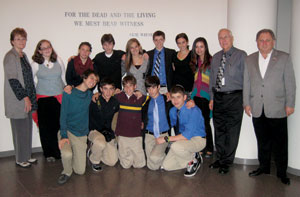 What are monsters? In storybooks they frequently emerge as strong, wicked, mysterious beings whose purpose is to do harm. In movies, they sometimes look like huge, frightening creatures dripping with venom. In real life, monsters appear as … Oh, wait. They don’t. When we’re young, we’re taught that monsters exist only in stories and fairytales. And, of course, it’s not logical to fear something that isn’t real. I grew up believing that monsters live only where they belong, in books and myths. My experiences as a participant in the Together We Remember program, turned that notion upside down. What I learned is that monsters can in fact become a very real threat to humanity.
What are monsters? In storybooks they frequently emerge as strong, wicked, mysterious beings whose purpose is to do harm. In movies, they sometimes look like huge, frightening creatures dripping with venom. In real life, monsters appear as … Oh, wait. They don’t. When we’re young, we’re taught that monsters exist only in stories and fairytales. And, of course, it’s not logical to fear something that isn’t real. I grew up believing that monsters live only where they belong, in books and myths. My experiences as a participant in the Together We Remember program, turned that notion upside down. What I learned is that monsters can in fact become a very real threat to humanity.
Your textbook monster might have green hair, menacing fangs and a giant spiky tail, but that isn’t what makes it evil. The reason monsters are to be feared is their intent. They generally seek personal gain and are willing to stop at nothing to reach their goals. Sometimes monsters believe that their evil behavior is for the good of many, and it may even seem that way to society. So if society approves, then are the monster’s actions truly bad? Before I participated in the Together We Remember learning program and visit to the United States Holocaust Memorial Museum in Washington, D.C., generously funded by Sam Devinki and sponsored by Midwest Center for Holocaust Education and CAJE/Jewish Federation, I believed the answer to that question was relatively straightforward: leaders who have the support of the people are doing their jobs well. Now I’m beginning to learn that this is not always the case.
Hitler and Nazi Germany fit perfectly into the evil leader/public approval model, Hitler being the monster of the Holocaust. Not only did he see no harm in killing millions, he truly believed that in doing so he was improving living conditions for everyone else. I learned that Hitler was an elected official. Not only did the German public not put a stop to what he was doing, they actually elected him into office. Learning that Hitler had such great public support got me thinking — was it really possible that Hitler convinced every person in Germany that killing was acceptable? What if these people had pretended to support him because they saw their peers doing the same and because they were afraid of doing otherwise?
I’ve come to the conclusion that the solution is not slaying the monster, as is portrayed in storybooks, because another monster may very well take its place. To take care of the problem, people — bystanders — must not let themselves become subject to the pressure society puts on them to conform to the social “norm.” Had more bystanders taken a stand against Hitler, they might have been shut down by Nazi power. If everyone together had voiced their true opinions, would Hitler have risen to his position of authority in the first place? In addition to teaching the history of the Holocaust, the Together We Remember learning experience showed 11 ninth-grade students that true courage is standing up for what’s right, even if that means defying public opinion. One person truly can change the world.
Sophia Porter was one of 13 students from the Kansas City area to visit the United States Holocaust Memorial Museum in November as part of the Together We Remember program.


